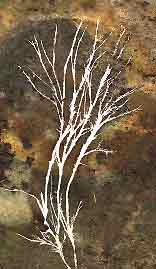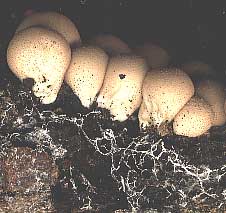 The part of the fungus that
feeds, grows, and ultimately may produce a mushroom or some other kind of reproductive
structure is something most of us never notice unless we look for it. It consists of
cobwebby strands of subterranean white stuff. The picture at the right shows such
cobwebby strands, and they are known as fungal hyphae. I found this
particular specimen in my garden. It grew between two large, flat, decaying leaves
plastered together by moisture. If you were to go into a forest and pick through moist,
decaying leaf-litter, you'd surely find some hyphae, too. The part of the fungus that
feeds, grows, and ultimately may produce a mushroom or some other kind of reproductive
structure is something most of us never notice unless we look for it. It consists of
cobwebby strands of subterranean white stuff. The picture at the right shows such
cobwebby strands, and they are known as fungal hyphae. I found this
particular specimen in my garden. It grew between two large, flat, decaying leaves
plastered together by moisture. If you were to go into a forest and pick through moist,
decaying leaf-litter, you'd surely find some hyphae, too.
As fungal hyphae migrate through such things as the decaying tree bark at the left, leaf litter, through soil, the moist pages of old, wet books, or maybe even among living cells of both plants and animals, they absorb nutrients and other substances they need. Once the hyphae attain a certain maturity and if surrounding conditions are right, then very complex changes occur inside the hyphae, and their many-shaped, many-colored, always-interesting-to-look-at reproductive structures may be formed. If you decide to grow mushrooms and you send off for a growing kit, you may be sent something called mycelium. Mycelium is a collective term referring to a mass of hyphae. You put your mycelium in a moist, warm place with the proper organic material to grow on, and then the individual strands of hyphae will grow from the mycelium, and eventually produce reproductive structures -- the mushrooms. You may be interested in reviewing the following books available at Amazon.com: |
 The picture at the left shows another view of hyphae.
This time the hyphae -- the white network of stringlike things -- is seen inside a cross
section of decaying tree bark. The hyphae have produced on the bark's exterior some nice
edible puffballs, Lycoperdon pyriforme.
The picture at the left shows another view of hyphae.
This time the hyphae -- the white network of stringlike things -- is seen inside a cross
section of decaying tree bark. The hyphae have produced on the bark's exterior some nice
edible puffballs, Lycoperdon pyriforme.